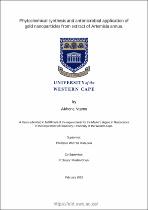| dc.contributor.advisor | Mabusela, Wilfred | |
| dc.contributor.author | Ntamo, Akhona | |
| dc.date.accessioned | 2023-05-25T09:39:06Z | |
| dc.date.available | 2023-05-25T09:39:06Z | |
| dc.date.issued | 2023 | |
| dc.identifier.uri | http://hdl.handle.net/11394/10043 | |
| dc.description | >Magister Scientiae - MSc | en_US |
| dc.description.abstract | Metallic nanoparticles synthesized using chemical methods and physical methods are considered toxic to the environment due to the use of toxic solvents. The biological synthesis methods such as the use of plant extracts are of interest because they are biocompatible, environmentally friendly, and relatively cost-effective. Gold nanoparticles (AuNPs) have been synthesized using plant aqueous extract as a reducing agent and have shown selective antibacterial activity and good antifungal properties. This study used an aqueous extract of Artemisia annua to synthesize biogenic AuNPs and tested them for antimicrobial activity. The A.annua-AuNPs were characterized using Ultraviolet-visible spectroscopy (UV-Vis), Fourier transform infrared spectroscopy (FTIR), Dynamic light scattering (DLS), and High-resolution transmission electron microscopy (HRTEM). | en_US |
| dc.language.iso | en | en_US |
| dc.publisher | University of the Western Cape | en_US |
| dc.subject | Gold nanoparticles | en_US |
| dc.subject | Artemisia annua | en_US |
| dc.subject | Phytochemical synthesis | en_US |
| dc.subject | Chemistry | en_US |
| dc.title | Phytochemical synthesis and antimicrobial application of gold nanoparticles from extract of Artemisia annua | en_US |
| dc.rights.holder | University of the Western Cape | en_US |

